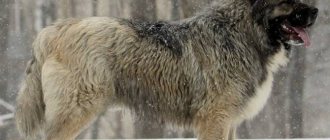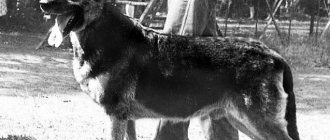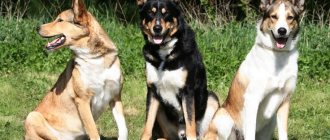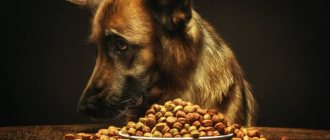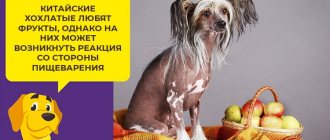What to choose: dry food or natural
The daily diet of East European Shepherds must include the following substances:
- proteins;
- lipids;
- carbohydrates;
- cellulose;
- enzymes;
- vitamins;
- micro- and macroelements;
- water.
To provide your dog with all these nutrients, you can choose one of two food options: “natural” or professional food.
Fans of the traditional method believe that you cannot raise a healthy dog without natural meat. Proponents of dry formulas argue that ready-made mixtures have a more balanced composition.
With proper product quality, good results can be achieved with both nutrition options. But natural food requires more trouble. When choosing a “natural” girl, follow these rules:
- Buy high quality products.
- Cook for your pet separately, do not feed scraps from the owner’s table.
- The volume of food of plant origin should not exceed a third of the total diet.
- Place the main emphasis on quality meat, offal, fish, eggs, cottage cheese.
- Suitable cereals include buckwheat, oats, and rice.
- Since large breeds have a slow metabolism, the amount of fat should not exceed 10%.
- Include vegetables and fruits in your menu.
- To avoid bloat, give food often, but in small portions. It is advisable for the puppy to rest after feeding and not make sudden movements.
The advantage of this type of food is that the owner can see what his dog is eating. The downside is that natural products do not provide all the dog’s needs. East European Shepherds are a hardy breed. But with a meager diet, the lifespan and quality of life are noticeably reduced. Therefore, feed your pet with vitamin and mineral supplements.
If possible, it is better to buy high-quality dry food for VEO. It has the following advantages:
- balanced composition;
- the recipe takes into account the needs of large breeds;
- high quality raw materials are used;
- the composition already includes all the necessary vitamins, minerals, prebiotics, chondroprotectors;
- There is no need to take additional therapeutic and preventive complexes.
It should be noted that shepherd dogs benefit from holistic and super premium food. Low-quality formulas are dominated by grains and bone meal, which will only worsen your health.
Features of East European Shepherds
Despite the fact that the International Canine Federation, unlike the RKF, still considers Orientals a subspecies of German shepherds, the difference in appearance and character in adult animals is quite noticeable, even if you do not take into account different colors. Compared to the Germans, VEO is significantly larger at the withers and more massive in the chest, with wider paws and thick undercoat. This is not surprising, because among the ancestors of East European Shepherds there were not only Germans, but also, according to various sources, Caucasian Shepherds, Alabais, and Laikas. Soviet cynologists developed the breed, taking into account the harsher climate of our country compared to Western Europe, as well as the requirements for the character of the dogs.
The East European Shepherd (VEO) became the first service dog in the USSR - indispensable for border protection, work in law enforcement agencies and other areas where exceptional endurance, calm disposition and extraordinary intelligence were required. Even today, while German Shepherds can increasingly be found as companion dogs, their Eastern European brothers are mostly bred for the purpose of service dog breeding.
VEOs are unpretentious, strong and harmonious dogs, and if you are lucky enough to become the owner of such a puppy, make sure that from early childhood you provide him with regular physical activity and high-quality nutrition that meets the needs of growing large dogs.
Daily diet from birth to one year
As the puppy grows, it goes through several stages of development. Breastfeeding continues for up to two months. Already in the third or fourth week, complementary foods are gradually introduced. These can be pieces of beef meat, if in the future you plan to switch the baby to natural food, or good food for puppies soaked in milk.
Gradually, new products are introduced into the diet. From two to six months the stage of active growth continues. At this time, the puppy is often fed in relatively large portions. The food already resembles the menu of an adult dog.
By 3-4 months, a shepherd puppy stops digesting lactose. Milk can cause diarrhea, flatulence, and other disorders. It is better to replace it with cottage cheese, kefir, fermented baked milk. For full development and formation of the nervous system, puppies are given fish oil.
At six months, the period of active growth ends, the volume of portions stabilizes, and the number of meals is reduced.
Approximate daily feeding rate for an East European Shepherd puppy:
| Products (in grams) | 1–2 months | 2–4 months | 4–6 months | 6–12 months |
| Lactic acid products | 500–1000 | 500–1000 | 500 | 500 |
| Meat | 150–200 | 300 | 400 | 400–500 |
| Fish (instead of meat) | 250–300 | 400 | 500 | 600 |
| Cereals | 100–150 | 150–200 | 300–400 | 400–500 |
| Vegetables, greens | 50–60 | 100 | 200 | 200 |
| Fish fat | 0.5 tbsp. l. | 1 tbsp. l. | 2 tbsp. l. | 2 tbsp. l. |
Nutrition composition
Meat for a dog is the predominant, but not the only element of the diet. To saturate the body with glucose and fiber, the puppy needs vegetables and cereals. Cereals are taken from among those available, preferably “coarse”, capable of nourishing the body and cleansing the intestines. This:
- barley;
- oatmeal;
- millet;
- buckwheat
Rice, rolled oats, poltavka, chives are added to the diet. Pearl barley is not included in the diet. Until the dog is two months old, the cereal is crushed. Hercules is fed not boiled, but with kefir, after soaking the flakes for half an hour.
It is useful to cook vegetable soups for your puppy with the addition of meat or sour cream. Cabbage, beets, onions, and carrots will do. It is better to feed carrots raw, grated, and seasoned with sour cream or butter. Potatoes and bread are not recommended, they will do more harm!
It is advisable to add greens to the puppy’s diet - parsley, dill, and other herbs. Scalded nettle or crushed nettle is a good addition to your diet.
The diet includes eggs and dairy products. Please note: milk is absorbed by the dog’s body until a certain age. Then the ability is lost and becomes the cause of digestive disorders.
Fermented milk products are useful at any age; cottage cheese, for example, should be present in the diet regularly.
Do you want to please your pet? Please note: spicy, salty, smoked, fried, sweet foods are prohibited. A healthy state will bring him much more joy. Dogs often enjoy eating fruits and berries. It is better to give foods one at a time, evening feeding - with meat, a feeling of fullness will allow him to sleep more peacefully.
Dry feeding
Choose high quality formulas. When purchasing, please read the following information:
- brand;
- content of proteins, fat, fiber;
- composition (grains should be in second or third place);
- purpose of feed.
Check the structure. In high-quality wet mixtures, pieces of meat, vegetables, and whole grains are visible. If canned food contains a lot of veins and connective tissue, it means that most of the recipe consists of offal.
To judge the quality of dry granules, look at the residue at the bottom of the bag. A large number of crumbs and small particles indicates low quality feed.
When to start feeding
If you decide to feed your baby VEO with industrial feeds, feeding can begin at 2 months. During the first weeks, the granules are soaked in warm milk or water.
Basic Rules
To ensure your puppy grows up healthy, follow these recommendations:
- Choose high quality food for large breed puppies.
- Follow the dosage. It is given in the instructions on the back of the package.
- Do not mix ready-made food and natural food.
- The basis of the diet should be dry granules. 25% of the menu may be wet canned goods of the same brand.
- Feed your babies on a schedule.
- Set the bowl of food out for 20-25 minutes.
- Change the water at least once a day.
Dosage
Depending on the age of the pet, the number of meals and the amount of food vary. The table shows the frequency of feedings and daily norms in grams.
| Puppy age | Number of feedings | Dry food | Semi-moist | Wet |
| 2–3 months | 7–6 | 370–560 | 425–645 | 1150–1650 |
| 4–5 months | 5–4 | 635–670 | 725–785 | 1850–2000 |
| 6–12 months | 3 | 760 | 850 | 2250 |
Caring for the East European Shepherd
Proper care of the East European Shepherd - first of all, grooming, regular examinations of the ears, eyes, and claws. There are no particular difficulties in keeping a shepherd dog. Good care is needed. You will need to comb the coat 2 times a week. During the molting period, the procedure is performed more often (daily!). The dog sheds heavily; it is especially problematic to cope with the abundance of hair during the period of intense shedding in autumn and spring.
- The dog's fur is combed with a metal comb.
- During the molting period, a “puffer” is added to the comb.
Clean the ears regularly and monitor the condition of the claws. If the nails do not grind down in time, they will need to be trimmed.
Hygiene procedures are introduced at a young age. East European Shepherd puppies will get used to hygiene procedures from an early age, and in adulthood they will accept manipulations calmly. Puppies need to be walked several times a day, creating the need to relieve themselves outside.
It is better to start care procedures as a game. A young individual will more easily accept the need for the process, bypassing the negativity during hygiene procedures.
You should not wash your pet frequently; it should be done as needed. When bathing, it is recommended to use special washing shampoos. For shepherds, it is advisable to use protein-based shampoos.
Popular brands
Popular super-premium brands include Hills, Eukanuba, and Royal Canin. The brands Orijen, Akana, and Grandorf are popular among holistic practitioners.
These manufacturers are sensitive to the quality of their products. Proteins take first place in recipes. This is natural meat, ocean fish. The developers use healthy grains: rice, oats. There are completely grain-free lines. The composition is supplemented with vegetables, fruits, and medicinal herbs.
Dry formulas
The American company Eukanuba and the French manufacturer Royal Canin offer separate foods for East European Shepherds. Choose food for large breed puppies from other manufacturers:
- Hills Canin Grove;
- Eukanuba Pappy;
- Royal Canin Junior;
- Akana Pappy Large Breed;
- Pronature No. 28;
- Grandorf for puppies with lamb or chicken.
Wet food
Canned formulas are used as a delicacy to add variety to the diet.
You should not feed your puppy only wet food, otherwise he will begin to refuse dry kibble.
The following brands of canned food are suitable for growing VEOs:
- Bozita;
- Almo Nature;
- Monge;
- Belcando;
- Barking Heads.
What foods are contraindicated
In addition to foods that are not suitable for all dogs, an East European Shepherd puppy should not be given meat or offal, cut into large pieces. Do not feed large amounts of cereal. All this can lead to volvulus, bloating, and worsen the functioning of the pancreas.
The following foods are also contraindicated for puppies:
- salted, smoked, peppered;
- sweets, confectionery;
- salo;
- fat meat;
- raw liver;
- River fish;
- bones;
- fresh bread;
- potato;
- grape.
Chronic overeating can lead to poor health consequences. If your puppy has regular watery eyes, ear discharge, rashes or diarrhea, then you have prepared the wrong diet.
Vitamin supplements
When naturally fed, a VEO puppy needs additional vitamins. The following complexes will help you develop fully:
- Irish Cal is a calcium supplement from Beaphar;
- Vi-Min Bosch – a combination of vitamins, minerals, microelements for puppies;
- 8 in 1 Polydex Polivit Calcium;
- 8 in 1 Brevers – vitamins with brewer’s yeast;
- 8 in 1 Polydex Gelabon plus;
- 8 in 1 Glucosamine.
If the puppy eats high-quality dry food, additional feeding is not needed.
What to feed
Avid dog lovers and experienced dog handlers know the saying: “The breed enters through the mouth.” The external data or exterior of the VEO puppy, the pet’s health, growth and full development depend on proper feeding. Feeding the puppy is consistent with the baby's growth rate.
A puppy settling into a new living space, getting used to its owner, experiences stress. In the initial days, it is better to adhere to the feeding regime that was practiced by the breeders running the nursery. Even food and feed should be selected with an eye to feeding in the nursery. As a rule, breeders are happy to advise the owner on emerging issues.


